Holiday Gifts for the Gardener
Posted on Tuesday, November 29, 2022 · Leave a Comment
First on my list for holiday gifts for the gardener is this: a subscription to this newspaper. Our local papers need subscribers in order to deliver to you the news you want but cannot get on-line. Yes, local news, gardening tips that fit your climate, obituaries and more. If your loved ones do not have subscriptions, think about giving one.

Consider a donation to a good non-profit like the Kilham Bear Center (photo by KBC)
Next, since most of us really need very little, think about a donation to a non-profit in your loved one’s honor. One of my favorites is a non-profit that for decades has nurtured orphan bear cubs, the Kilham Bear Center in Lyme, NH. The Center this year is nurturing and caring for more than 100 baby bears whose mothers have been killed by cars or hunters, and that would otherwise not survive. The Center has over 19 acres of fenced forest for the bears, and serves Vermont, New Hampshire and Massachusetts.
You can donate to The Kilham Bear Center at PO Box 37 Lyme, NH 03768 or go on-line to
https://kilhambearcenter.org/. On-line there are photos and videos of the bears. Visiting is not possible, as they want the bears to have as little contact with humans as possible because their goal is to return all to the wild where they avoid humans.
Other non-profits I like include The Native Plant Trust, the Audubon Society and the Nature Conservancy. As a supporter I get the Nature Conservancy magazine and I never cease to be amazed at all the good projects they initiate or support. And of course most states have nice non-profits supporting public gardens and wildlife areas that need our support.

Cobra Head weeders now come in two sizes
Along with new products I like, each year I have to mention a few old favorites. The Cobra Head Weeder is a simple, well-made tool that virtually all gardeners love once they’ve tried it. Shaped like a curved steel finger, it will get under weeds or flowers to lift them from the earth. I use it for planting as well as weeding. Found at most garden centers or on-line at www.cobrahead.com for about $30. They now have a version for smaller hands and a long-handled weeder as well.
Books are a great present. I usually mention author Michael Dirr, my favorite expert on trees and shrubs. All his books are well researched, complete, and opinionated. My favorite is his classic, the “Manual of Woody Landscape Plants: their Identification, Ornamental Characteristics, Culture, Propagation and Uses”.
Another classic is Barbara Damrosch’s “The Garden Primer”. This book is a good reference on almost anything a gardener would wish to know. And at under $20 in paperback, it is great value for an 800-page book. More reliable than many of the on-line experts, I dare say.
Lastly a pair of books that work well together. First, Doug Tallamy’s “Nature’s Best Hope: A New Approach to Conservation That Starts in Your Yard”. This explains in readable, layman’s terms why what we select for our gardens impacts birds and pollinators.
A good companion to Tallamy’s books is “Essential Native Trees and Shrubs for the Eastern United States” by Tony Dove and Ginger Woolridge. This book supplies all you need to know for selecting the right trees and shrubs for your land to support wildlife.
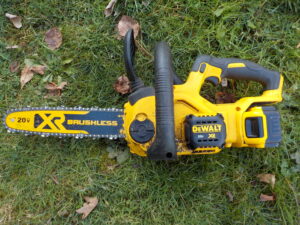
An electric chain saw can be useful for small project
But on to other needs of gardeners. Consider a small electric chain saw. They are safer, quieter, and easier to start and to use than gas powered ones. I have a DeWalt DCCS620 chain saw that has a 20-volt battery, 12-inch bar and weighs just 9 pounds. Great for cutting up downed branches, removing small trees and more. Available locally at $250 or less.
For gardeners who start seeds indoors each spring, there is an alternative to all those flimsy plastic 6-packs. You can buy a metal soil blocker that you can use to make small cubes of a soil mix for your seeds. Available from Johnny’s Seeds or Gardeners Supply, about $40.
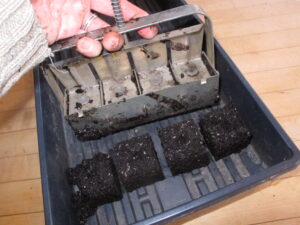
With this simple tool, you can make Soil blocks for starting seedlings
Another great product for starting seedlings are electric heat mats. These sit under flats of seeds planted indoors, providing heat that speeds up the germination process. They are available in two sizes – enough for one flat or a big one for four or more flats. Great for things that take a long time to germinate.
For stocking stuffers I like seed packets. Give your loved ones seeds of less common vegetables and flowers that they might not find at the plant nursery. Garden gloves are great gifts, we all use them in spring and fall, and some people use them all summer, too.
Lastly, my wife, Cindy, swears by a natural bug repellent made in New Hampshire, White Mountain Deet-Free Insect Repellent (
http://www.whitemountaininsectrepellent.com). It doesn’t take much of this stuff to keep away black flies, she says. It comes in a 4-ounce bottle of all-natural ingredients (no fillers) for $15 plus shipping. Great stocking stuffer.
Use your imagination. There are so many nice things a gardeners will appreciate, including your own time promised for weeding in the spring!
Henry is a garden consultant, public speaker and the author of 4 gardening books. Reach him by e-mail at
henry.homeyer@comcast.net or PO Box 364, Cornish Flat, NH 03746.
The Art of Weeding
Posted on Thursday, May 27, 2021 · Leave a Comment
When you face a flower bed and can’t immediately tell what’s a weed and what’s a flower, you have a situation my wife, Cindy Heath, calls Code Red. It happens to the best of us at times, myself included. So what does a gardener do?
My wife, Cindy Heath, likes to begin a weeding project by edging the bed. She has a pair of wooden pegs 12-inches long that anchor a 50-foot piece of twine. She unwinds the twine and stretches it between the two pegs when edging a straight bed. Curved beds have to be edged by eye.

An edging tool helps create clean lines
The edging tool Cindy uses is a half moon-shape on a long handle. She pushes it into the earth with a foot, then tips the handle back to create a little moat when she removes the soil and grasses. Edging discourages lawn grass from creeping into the bed.
Next, she said, find the flowers. At this time of year weeds and rambunctious spreaders like Forget-Me-Nots may be taller than some of your perennials. Get close, and paw through the foliage. Pull a few weeds around your perennials so that you can see them, and so that you will avoid stepping on them or inadvertently pulling them.
If you pull a “weed” you don’t recognize but see that there is potting soil in the roots, you know you just pulled a flower you bought. Oops. Get it right back in the soil. If you have an inexperienced gardener helping you, you could flag the plants with bright orange surveyor’s tape.
Cindy said she likes knee pads because she likes to weed on her hands and knees. I personally find them hot and uncomfortable, but you may wish to try some. Me? I like something to kneel on, a foam cushion, or such.
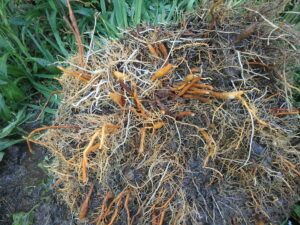
Day lily roots are orange to brown and have fat portions
In this season, Cindy says bug spray and a good hat are essential – black flies can be real pests, reducing your willingness to continue. Some gardeners like beekeepers hats to keep black flies off their faces, but I don’t. I spray the top of my hat, which does a pretty good job of repelling biting bugs without getting repellent on my face.
A good hand tool is essential for loosening the soil and teasing out roots. I think I have tried every weeding tool made, and like the CobraHead weeder best. It is like a steel finger: a single curved tine with a sharp, widened tip. Made in the USA and with a blue handle made from re-cycled plastic, it never seems to get dull and lasts forever.
If I have a large clump of grass to remove, I loosen the soil around it, then push the tool into the soil; the curve of the tool allows the blade to get under the clump. Then, pulling from above with one hand and below with my weeder, I can pull the clump right out. It is great for loosening tree roots that have invaded a bed, too.
When should you weed? Whenever you have the time and inclination. I recommend doing a little weeding every day. Sort of like brushing your teeth or washing your coffee cup. Just make it a habit so the weeds don’t get ahead of you.
Clay soils are heavy and sticky when wet, and much like concrete when dry. If you have them, work when they are moist, but not soggy. If dry, water moderately with your hose. Keep a bucket of compost with you and mix it in as you go along. Compost will lighten the soil, making it easier to weed or to plant things to fill in the spaces where the weeds were.
Sandy soils can be weeded any time, but I recommend adding compost as you go along. Nice loam is what we all want, and even that can benefit from some compost. I buy a 3-yard dump truck-load once a year and it has helped my soil become close to perfect.
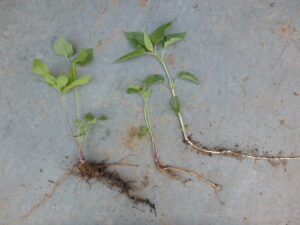
Weed roots are often long and able to send up new weeds at each node
But back to Code Red. If you have weeds that spread by root, things like goutweed or witch grass, you may need to “bareroot” the flowers that have been invaded. That means digging up a clump of flowers and washing all the soil off so that you can identify and separate the weed roots from the roots of your perennial flowers. Then replant.
Learn to recognize the roots of your garden flowers. Many invasive weeds have long, whitish roots with nodes along them and can send up new leaves from any of those nodes.
Lastly, after weeding it is advisable to either mulch your bed, or install a ground cover that will shade out any weeds that try to establish themselves. If you grow your flowers close enough together, weeding will become a minor chore.
It does take time to establish most ground covers, so you may wish to plant some annual flowers in the spaces between your peonies or phlox. Buy six-packs of common annuals like snapdragons, cosmos and zinnias at your local garden center. Plant them six-to eight-inches apart, stand back, and let them grow! They will delight you with blossoms for much of the summer and into the fall.
Henry is the author of 4 gardening books. He can be reached at
henry.homeyer@comcast.net or P.O. Box 364, Cornish Flat, NH 03746. Please include a SASE if you wish a response by mail.
Gardening Gifts for Mother’s Day
Posted on Wednesday, April 20, 2016 · Leave a Comment
When I was a boy, I generally bought my mom some pansies in a little wooden box for Mother’s Day. Mom is long gone, but I’ll be thinking of her and all she did for me when Mother’s Day rolls around on May 8. If your mom is a gardener, or just appreciates the beauty of the living world, there are plenty of good gifts for her.
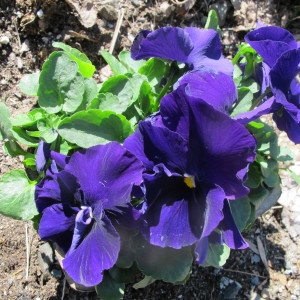
Pansies
I like giving pansies for Mother’s day for a number of reasons. First, they are cheerful and full of color. And they are hardy, surviving and thriving outdoors even if we get frost. And they look good even without wrapping paper (I am still challenged when it comes to wrappping).
Each pansy plant is relatively small at the beginning of the season, but they will give a nice punch of color even while they are bulking up. Pansy grower Jenny Wright of Unity, NH tells me that pansies “…would rather be in England where it is cold and rainy.” So later, in August, they tend to sulk until fall rains come.
Perennials are good gifts, too. Right now some of my hellebores are blooming. Don’t know hellebores? You should. These early-spring beauties have evergreen leaves and come in a variety of colors from white to pinkish to shades of purple or even green, both as singles and doubles (with extra petals). Hybridizers have been developing new colors because they are relatively fool-proof plants.
Hellebores are plants that do fine in shade, or partial shade. They prefer moist, well-drained soil but will do fine in dry shade, too. In the beginning of spring the evergreen leaves on hellebores look pretty ratty. I’ve cut those back to tidy up the bed, and I see that new leaves are already unfurling. I’d say that by May 1 the hellebores will be looking dramatic.
Another early spring flower that will look good on Mother’s Day has a rather unappealing common name, lungwort. I prefer to call in by its botanical name, the one used by scientists, Pulmonaria. There are actually three species of Pulmonaria but all are very similar. Cold hardy to minus 40 Fahrenheit, they grow in full to partial shade in ordinary garden soil of moderate fertility, but don’t do as well in a very dry location.
Pulmonaria is a good groundcover, one that stays relatively low and spreads by root. The flowers can stand up above the leaves to 8 to 12 inches, but the leaves are low. Most varieties sold have spotted leaves, though I have one, probably Pulmonaria angustifolia, that does not. Mine has absolutely iridescent blue flowers that almost seem to light up at dusk or on a cloudy day.
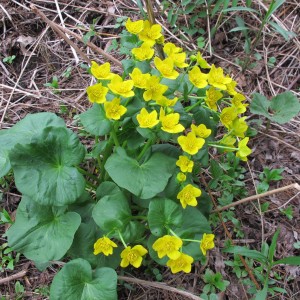
Marsh marigold
Marsh marigold (Caltha palustris) is a wildflower, but one that is sometimes sold in nurseries. As the name implies, it grows in wet places, even in standing water. It needs a location that is at least moist all year. It is a brilliant yellow flower about 2 inches in diameter. It is hardy to Zone 4, minus 30. It is not related to annual marigolds sold everywhere.
Your mother probably doesn’t have marsh marigolds – most people don’t – so if she has some wet areas near her garden, think about finding one for her. There is a fabulous double variety called ‘Multiplex’ that I planted near my stream last year. I got it at E.C. Brown Nursery in Thetford, VT. The leaves are up, and I can’t wait until the blossoms appear.
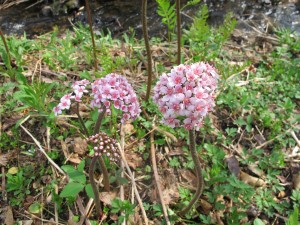
Darmera peltata
Another lesser known plant near my stream is the umbrella plant (Darmera peltata). This blooms in May before the giant leaves appear. It is a native – I have seen it wild along the banks of the Rogue River in Oregon – but it is not native here in the east. The pink flowers appear as drumsticks of florets on a tall stem. The leaves will stand up 2 feet and be 2 feet in diameter later this summer. Available at E.C. Brown Nursery.
I am reluctant to recommend buying a tree or shrub as a gift unless I know the recipient has asked for it. After all, shrubs take up more space than flowers, and generally last longer. But you know Mom best, and if she likes flowering shrubs and has space for more, think about getting the early blooming azalea ‘Cornell Pink’ (Rhododendron mucronulatum).
This shrub blooms before most others (except February Daphne). As the name implies, the blossoms are pink. A nice pink, not garish at all. Its only liability is that it blooms so early that some years a hard frost can ruin the buds, I’m told. It’s never happened to me, or to anyone I know, but the literature always warns about it. The shrub can get large – 8 feet tall and wide, or larger – if not pruned.
If you’d rather not buy plants, think about other things useful to a gardener. A CobraHead weeder (www.cobrahead.com), some nice garden gloves, or perhaps a colorful tubtrug. Trugs, as I call them are handy bucket-substitutes. Unlike the standard 5-gallon pail, these are flexible with 2 soft handles. Easy to pick up with one hand, they come in sizes from very small to quite large (11 gallons). Available at Gardeners Supply (www.gardeners.com), or your local garden center.
Mom, if you’re watching me, I planted some pansies this week. I hope you like them.
Henry Homeyer is blogging at https://dailyuv.com/henryhomeyer. Sign up for an e-mail every time he posts. He is the author of 4 gardening books, and lives in Cornish Flat, NH.
Vegetable Gardening
Posted on Wednesday, June 4, 2014 · Leave a Comment
I planted much of my vegetable garden early this year. Living in a cold spot, I usually wait until June 10 to plant frost and cold-sensitive plants. But lured by perfect warm weather I planted most of my tomatoes on Memorial Day weekend. The soil was 60 degrees and sun strong. Then the weather turned chilly and wet. My tomatoes will survive this, and I can always cover them if there is threat of frost. Still, after all these decades, I should have more patience. Tomatoes, peppers, eggplants, cukes, squash: all these like hot weather.
I did not plant my vine crops early, however. I like to start cukes, squash and pumpkins indoors in May in 4-inch pots, growing them under lights until they have vines a foot long with several leaves. Or sometimes I will buy a few nice big plants. I do this because of the dreaded striped cucumber beetle, a pest that can – and will – eat up a plant’s first 2 leaves in one night. But a bigger plant can survive a few beetle bites without trouble.
Another way to minimize beetle damage on any crop is to cover it with row cover, also called Reemay or Agribon (both are trade names). Row cover is a thin woven fabric that breathes and allows more than 90% of the sun’s light to pass through – without burning your plants the way clear plastic would. Got trouble with little green caterpillars on your broccoli? Cover it up. Rain will pass through it, too.
Although you can just lay row cover on your plants, I like to stretch it over wire hoops that are sold for the purpose. It gives the plants room to grow. In either case, you must seal the edges or some critters will crawl under for a free lunch. You can use earth staples sold for the purpose, or just use those stones that Mother Nature pushes up out of the soil every winter.
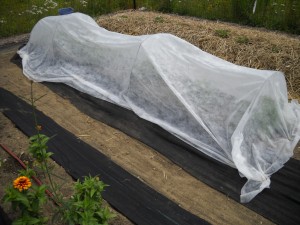
Row cover with hoops
Row cover holds in some heat, which is good at this time of year. But if you need insect pollination – all the vine crops need it – you must take off the covers when they flower or hand pollinate, which is time consuming. I sometimes leave row cover on eggplants all summer as they are wind pollinated.
Thinning plants started outdoors by seed must be the most tedious of all garden tasks. Carrots, lettuce, rutabagas, beets? All need to be thinned for best results. Beets and carrot babies are good to eat if you wait until the end of the month of June. I try to have them thinned to one inch apart by the Fourth of July, with a wider spacing a month later.
Beet greens are a classic early summer dish that I like served with a sprinkling of gourmet rice wine vinegar instead of the calorie-packing butter that I use on my asparagus. And just a reminder, don’t keep picking asparagus for more than 3 weeks. Oh, it’s tempting to keep picking the spears that pop up to replace those you’ve eaten. But the greens are needed to feed the roots, and picking for too long will cause the patch to run down.
My asparagus patch produced well this year, its third, and I am rewarding it with regular weeding, a light top-dressing of organic fertilizer and a little compost. Then I will cover the compost with a layer of wood chips to minimize the need for weeding later on this summer.
Last fall I covered up my wide raised (mounded) vegetable garden beds with hay, straw or fallen leaves after cleaning out most of the weeds. This really minimized my work this spring. I pushed off the winter cover of mulch into the walkways in early May, which kept weeds from starting up there. The sun warmed the soil, spawning some weeds. But I pulled them out or sliced them off before they got established, and then planted without rototilling.
I know some gardeners who love their rototillers as much as they love their spouses. They do create a lovely-looking bed, and they make all the weeds “disappear”. But if you chop up witch grass or perennial weeds, each piece may well produce a new plant in a few weeks.
Many weeds have what I call ‘photo-triggers’. This means that they need some light to know it is time to wake up and grow. Buried down 4 inches, the seeds can sleep for years. Turn them up with a rototiller and they germinate. So at planting time I try to minimize how much I disturb the soil. I use an ancient 4-tined potato hoe and my CobraHead weeder (www.CobraHead.com) to do most of the soil work.
We’ve all heard of the “runner’s high” – a feeling of well being from running. Sometimes I get a “gardener’s high” instead. Planting a garden will do it for me. I just wish I got the same feeling after an afternoon of weeding – instead of a tired back.
Henry Homeyer’s Web site is www.Gardening-Guy.com. He is the author of 4 gardening books, and a children’s fantasy-adventure, Wobar and the Quest for the Magic Calumet.
Early Summer Chores in the Vegetable Garden
Posted on Wednesday, July 3, 2013 · Leave a Comment
I don’t recall ever hearing a version of George Gershwin’s song, Summertime, that I didn’t like. But I’m not sure about the accuracy of that line “and the livin’ is easy.” Right now I have a lot to do in the garden.
Let’s start off in the vegetable patch. I’ve had a lot of rain in the last 3 weeks, so everything has been quite happy – especially the weeds. Of course since the soil is moist, weeds are pretty easy to pull. But still, I do not just pull weeds. Yank on the top of a weed, especially a big perennial weed like a dandelion or a burdock, and it breaks off. The roots stay behind to produce the leaves all over again. Sisyphus, the Greek who kept pushing the boulder up a hill in mythology, could have been a gardener – without a good weeding tool and proper technique.
In order to keep weeds and grasses from re-sprouting, you need to get the entire root out. After all, they evolved with herbivores that not only bit off their stems, but often gave a good yank. To survive, they must re-sprout from roots. So learn to know your weeds and their root systems. To remove a weed with tap root, you need to loosen the soil. In general, the bigger the plant, the longer the root.
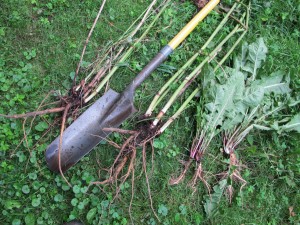
From L to R, dock, drain spade, dandelions
Dock (Rumex spp.) is a big, tall weed that loves my garden. It has a root that can go down more than a foot. If the soil is loose, moist and fluffy I might be able give a long slow pull and remove all its roots. But in dry or compacted soil, I need to use a drain spade (mine is pointed and its blade is 16 inches long by 5 inches wide) or a garden fork to loosen the soil before pulling. I plunge it deep into the soil a couple of inches away from the weed, and pull back to loosen the soil. Of course, the blade may sever a side-root if I am not careful.
For ordinary weeds I use my CobraHead weeder, which is a like a steel finger, curved and sharp. I can get it under a clump of grass or weed and loosen the soil before I begin to tug from above. It’s very effective, especially to tease out long roots of invasive grasses.
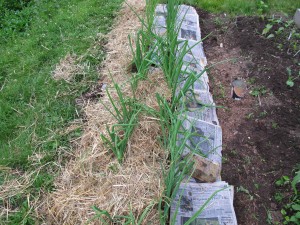
Mulching onions
I recently weeded my onion patch. Onions hate weeds – in part because weeds steal their moisture. After weeding, I soaked a pile of newspapers and then spread them out alongside the onions and in the space between my double rows. I didn’t put newspaper between the individual onions in their rows, as they are too close together and it would have been too much trouble. I spread mulch hay over the newspaper to keep it in place. The newspaper smothers any seeds that might germinate and try to grow after my late-June weeding.
When I give lectures on gardening, I tell my listeners that they must thin their beets and carrots on the Fourth of July at 10am. Or around that time. Carrot seeds are tiny and most of us manage to plant too many, too close together. And we all hate killing baby carrots. But if we don’t thin them, the carrots will compete with their kin for water and soil nutrients – just as weeds do. Thin them now, today, to one-inch spacing. A few companies (Johnny’s Seeds is one) sell pelleted seeds that are sold covered with a layer of clay, making the seeds a size you can handle and plant individually. Look for them.
Beet seeds are not seeds at all, but seed capsules. So no matter how carefully you spaced the “seeds”, you must thin them now as usually 2 or 3 plants start from each seed capsule. There are a few varieties like ‘Moneta’ that have just one seed per capsule, so you can avoid thinning.
This is also a time to start second (or third) plantings of lettuce and other greens. I’m eating my first crop of lettuce and new plantings will help to keep the salad bowl full all summer. I’ll plant a few seeds every 2-3 weeks. You can plant a second crop of broccoli from seed now, too. That will mean that you get big juicy heads of broccoli in September and October.

Apples ready for thinning
This spring my apple trees produced more blossoms than usual. That means that there will be huge numbers of apples, come fall, but that each will be smaller – unless I take action. A tree can support just so much fruit. Thinning out – removing fruit – will promote bigger apples. I should have already thinned my apples by now, but it will be all right to do it now. See a clump of apples? Leave just one or two and remove the rest. I’ve read that it’s good to space apples 4 to 6 inches apart on a branch by thinning. Thinning will also help to minimize the alternate-year pattern for big fruit loads that are common with some varieties.
You can also put paper bags over some apples (and tie off the bags with twist ties) to have a few apples
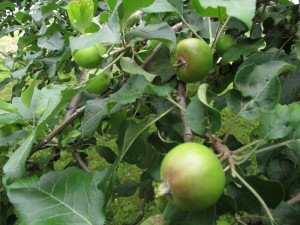
Apples after thinning
that are perfect and unblemished. If you’ve had trouble with apple maggots in the past, buy a few fake red plastic apples at the garden store, and cover them with a sticky substance (one brand is called Tanglefoot and is suitable for use by organic gardeners). This will catch the moths that are attracted to the redness of the fake apples – moths are not too bright.
So use your weekend to get caught up on some gardening chores. And okay, take some time off to snooze in the hammock if you must.
Henry Homeyer is the author of 4 gardening books and a new fantasy-adventure for children about a boy and a cougar. His web sites are www.henryhomeyer.com and www.Gardening-Guy.com.
Holiday Gifts for the Gardener
Posted on Wednesday, November 28, 2012 · Leave a Comment
When I was a boy we made lots of our own Christmas gifts. I remember making a wooden whale for my dad that held pencils – it had little holes just the diameter of pencils I drilled into it. I must have been 8 or 9 when I made it, and I have no idea how I was able to do it without his help. Maybe it was a Cub Scout project. Not elegant, but there was lots of love in it.
As gardeners, we can make presents, too – if we have extra produce that we have put up. Dried tomatoes, pickles, even a frozen bag of blueberries or elderberries would be much appreciated, I’m sure – though putting frozen berries under the tree might not work well. And then there are heirloom seeds. I grow certain tomatoes and peppers that are not commercially available. I save seeds each year, and share with friends. These are all good presents that cost nothing.
Although seed catalogs used to come in the mail in mid-winter, now most seeds are available on-line before Christmas. A few packages of seeds are nice low-budget gift. I get many of my seeds from Johnny’s Select Seeds in Maine (www.johnnyseeds.com), High Mowing Seeds of Vermont (www.highmowingseeds.com) or Hudson Valley Seed Library (www.seedlibrary.org), which is a non-profit with nice heirloom seeds.
From Johnny’s this year I got two kinds of tomato seeds that are fairly resistant to late blight. First there was the Defiant F-1which produced well early on, but then died off when other fungal diseases took over. Then there was Mountain Magic, a small salad-type tomato that was very disease resistant and productive for me. All of the High Mowing seeds are organic, which I like.
Also in the cheap (or shall we say the ‘frugal’) category is a gift certificate for an hour or two of weeding. That’s a gift anyone would really appreciate. And feel free to send me one! Weeding is a pleasant enough task, but is always more fun if done with a friend.
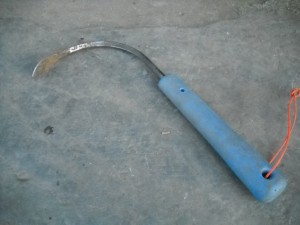
Holiday Gifts
Before going on to more conventional gardening presents, let me point out that most things I will mention are available locally at your garden center, feed-and-grain or hardware store. I firmly believe that it is better to buy locally than on line, as that keeps our family-owned businesses healthy. And they are the ones that support our teams, schools and charities.
Gardening gloves are always useful. The Atlas Glove company now makes a thin, tough nitrile gardening glove that is sold for under $10. Stretchy nylon coated with waterproof nitrile. Buy them locally, or from Gardener’s Supply Company (www.gardeners.com) in a variety of pretty colors.
Also from Gardener’s Supply is a nice expandable bamboo trellis. A friend gave me one, and I used it for growing my peas. Instead of letting it touch the soil, I tied it onto posts so the bottom was 6 inches off the ground, to minimize rot. Cost? $20-$25, depending on size.
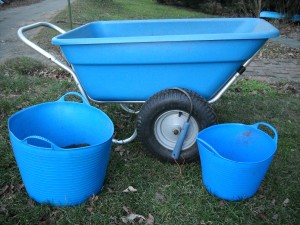
Holiday Gifts
On the high end of the spectrum would be a new wheelbarrow. The best I have found is the Muller’s Smart Cart (www. mullerscarts.com). It is a 7 (or 12) cubic foot polyethylene bin that pops in (or out) of an aluminum frame. I have the 7-ft model and have used it hard to over 10 years, yet have never had a flat tire or any other problem with it. The fact that the barrow part is removable allows me to use it to wash the dog in it or carry manure in the back of my sedan. They cost $350, with free shipping. I chose the wide tires, not the bike tires, and find them great, even in soggy conditions. This is a very high quality wheelbarrow that is rated to carry up to 600 lbs.
Every year I recommend my favorite weeding tool, the CobraHead weeder (www.CobraHead.com). This tool is great for getting under weeds, teasing out roots, stirring compost or fertilizer into planting holes, planting bulbs and more. You should be able to find it locally. Cost? About $25.
A gardening magazine subscription would be nice, too. I get Fine Gardening magazine (www.finegardening.com). The magazine has a nice balance of growing information and design ideas. Excellent color photography. $29.95.
I’ve fallen in love with TubTrugs. These are brightly colored flexible buckets I use for carrying weeds, compost and even water. From 3 Gallons to 10 gallons, their flexible handles make them easy to carry. Found locally or from Gardeners Supply in a variety of sizes and colors, around $10.
Gardening books are good gifts, but look for quality info, not necessarily glossy pictures. My website, www.Gardening-guy.com, lists about 25 good ones. Just click on the “Gardener’s Basic Library” on the top bar.
So enjoy the holidays, but remember that Santa’s elves make lots of presents. Get creative and be an elf your self!
Henry Homeyer’s new book is for children ages 8 and up. It’s called Wobar and the Quest for the Magic Calumet, and is a fantasy-adventure about a boy with a mustache – and a cougar who is his best friend. Go to www.henryhomeyer.com to learn more.
Spring Forth Into Spring
Posted on Wednesday, May 16, 2012 · Leave a Comment
This is a busy time for all of us in the garden. Not only are weeds up, some of them are already blooming. I try real hard to keep weeds from spreading their seeds in my garden beds, so I am doing my best to pull them now before they bloom and make seeds. And there is so much else to do I’m not sure if I have time to write this column!
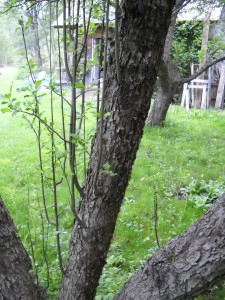
Apple sprouts on trunk
Apple and crabapple trees are blooming everywhere, which draws my eyes to them. I can’t help but notice that so many need a little late pruning. What I keep seeing are root sprouts coming up alongside the trunk of these lovely trees, which is a distraction. And it only takes 5 minutes with a pair of loppers or a hand saw to remove those shoots.
While you’re at it, you may wish to take off any little branches that are sprouting from the main trunk below the first scaffold branches (those larger branches that reach out and up, and that have all those blossoms on them). A nice clean trunk is much better than one cluttered with unwanted sprouts.
Then there is the vegetable garden. I know we will still have frost here in Cornish Flat, so all those tomatoes and peppers and squash that I have started by seed inside need to stay in their pots. What I can do now, however, is” harden off” those seedlings. Hardening off is the process of getting seedlings ready for life outdoors.
Each nice day I should (but don’t always) carry all 12 trays of seedlings outdoors so my plants can work on their tan. That’s right, seedlings are like us – they need to start with just a little sunshine and breeze each day. Two hours of morning sun is good for a start, then 4 hours, then 2 hours of afternoon sun, and so on, increasing exposure until their leaves won’t burn or dry out even if they’re in the sun all day. If you buy seedlings it’s good to give them time to get used to the outdoors, too. Greenhouses do shelter seedlings considerably.
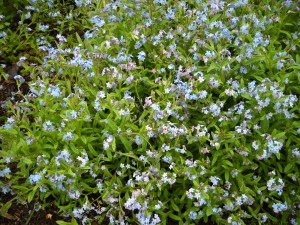
Forget Me Not
Right now I have thousands of forget-me-nots (Myosotis sylvatica) blooming everywhere: in garden beds, in the lawn, in the vegetable garden – even on the banks of my little stream (they love water). If you don’t have this fabulous, exuberant flower, you should. I wish I could give every reader a clump, but I bet one of your neighbors will share some with you, as most everyone has it. I rarely see them for sale at nurseries, but a few of the better ones do. Many flower books say they are biennials, but I’m not sure that’s true. Biennials only bloom in their second year, and then die. I have so many, it’s hard to know if they are re-seeding or coming back from their roots. So they may be perennials.
While weeding a patch of daffodils recently, I decided to take advantage of the fact that I had thoroughly loosened the soil surface. I spread my favorite organic fertilizer, Pro-Gro over the soil surface and scratched it in with my favorite weeder, the CobraHead. I had notice that those daffies were not flowering as previous years and decided to give the soil some extra nutrition and get rid of the weeds that were competing with them. Next spring I should have better blossoms.
Some gardeners like to divide big clumps of daffodils, though I generally don’t get around to it. The problem is that by fall I don’t know where those big clumps that need dividing are. The solution? Make some markers now and stick them in the soil. That works for marking places that need more bulbs, too.
It’s past time to rake off that leaf mulch or straw if you covered your vegetable garden with mulch last fall. I just raked mulch off my beds and into the walkways last week. By exposing the soil to the sun I do 2 things: I let the soil warm up and dry out more quickly, and I encourage weed seeds to germinate. I want the weeds to germinate before I plant so that I can hoe them over or pull them out, killing them before I plant. I also have a flame weeder which will burn off dozens of small annual weeds with a single, quick pass. (Available at Johnny’s Seeds or Fedco Seeds). But it does use propane, so is not as eco-friendly as hoeing.
Traditional gardeners grow their carrots, corn and cauliflower in narrow rows on flat ground. I don’t. I have mounded up beds that are 3 feet wide and 6 to 8 inches higher than the walkways. Wide beds produce more planting space in a garden when compared to those with narrow rows because there are fewer walkways. The wide, higher beds allow roots to spread wider and deeper than in traditional beds, and dogs and kids tend to stay out of them.
But if you have a sunny, warm weekend, don’t spend all day pulling weeds or working. Take time to sit and enjoy your flowers – and the butterflies, kids and dogs that love the garden, too.
Henry’s Web site is www.Gardening-Guy.com. It now has a search engine for finding any past columns you might have missed.





















